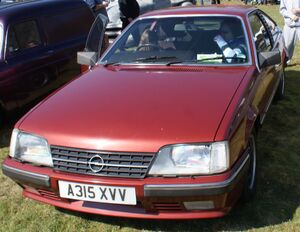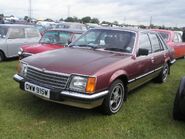
Opel Monza
The Opel Senator was a full-size luxury automobile, two generations of which were sold in Europe by Opel, from 1978 until 1993. A saloon, its first incarnation was also available with a fastback coupé body as the Opel Monza and Vauxhall Royale Coupe.
Through the international divisions of General Motors, it was also known in various markets as the Chevrolet Senator, Daewoo Imperial (in South Korea), Vauxhall Royale (until 1983) and Vauxhall Senator (which took the place of the Royale on Vauxhall models when the Opel brand was phased out from 1983).
The original Senator shared its platform with the smaller Opel Rekord, the latter being lengthened to make the Senator.
The second generation of that car, from 1987, shared its base with the Opel Omega, which was again lengthened to produce the Senator.
Senator A[]
The Senator A (the "A" being used for differentiation here, but not a marketed name) was a lengthened version of the Opel Rekord E, complemented by a three-door fastback coupé version on the same platform called the Opel Monza, which was planned as a successor for the Opel Commodore coupé.
Different market names[]
The Senator A and Monza were initially sold in the United Kingdom as the Vauxhall Royale (and Vauxhall Royale Coupé), because the Opel marque was not so well established, but they were also under their Opel names. The vehicle was also available in South Africa as the Chevrolet Senator until 1982, when it was re-badged as an Opel. All year models were available in Australia, as the Holden Commodore in Sedan and Wagon variants, though the Monza Coupe was not available. Local racing legend, Peter Brock, had plans to import, modify and market the Opel Monza Coupe as Holden Monza Coupe with the Holden 5 Litre V8 fitted, through his own HDT (Holden Dealer Team) business, but the plans eventually fell through. The Holden models, which were built locally, had different front, rear and interior treatments, with local drivetrain options, including Holden's 3.3 Inline 6 cyl, 4.2 Litre and 5.0 Litre V8 engine options. Holden still markets the Commodore, but on their own Zeta Platform, which the new Camaro is also based upon. Commodore has been Australia's best selling car for the past 16 years.
Engines[]
The engine range for the first phase of the model's life included the 2.0E, 2.5S (and later the fuel-injected E), the 2.8S and the newly developed 3.0E, which had 180 PS (132 kW; 178 hp) and 248 N·m (183 lb·ft) with fuel injection. The 3-speed BorgWarner automatic transmission from the Commodore range needed to be modified to cope with the new and improved power outputs. Opel's own 4-speed manual transmission was not up to the job and, instead of putting in a more modern 5-speed manual gearbox, Opel turned to transmission producer Getrag, and installed their 264 4-speed manual gearbox in the early Monzas. This was soon replaced with the Getrag 240 for the 2.5 and 2.8 engines, and the Getrag 265 for the 3.0E; both 5-speed manual gearboxes.
The straight-six engines were all of the CIH (camshaft in head) same design earlier used in the Commodore models. The CIH configuration is originated from the 1,7 and 1,9 litre straight 4 engines that was first used in the Opel Kadett and Rekord models in 1966, and subsequently was an engine layout that stayed in the Opel cars up until 1993 (the last CIH engine factory mounted was a 2,4 litre straight 4 CIH used in the Opel Frontera).
With the 3.0 litre engine, the Monza was the fastest car Opel had built up until then, capable of speeds of 215 km/h (134 mph), and 0–100 km/h (0–62 mph) in 9.5 seconds.
1982 facelift[]
The original Senator and Monza were face-lifted in the end of 1982. In the UK, the Senator "A2" (as it is sometimes referred to) initially sold only as an Opel, before being re-badged for the UK (as a Vauxhall) in 1984. The A2 Monza was only sold as an Opel.
The facelifted car looked similar to its predecessor, with relatively minor changes: headlights increased in size, and chrome parts were changed to a matt black or colour-coded finish.
Interiors were improved, and engines changed. Now, straight-4 CIH 2.0E and 2.2E engines from the Rekord E2 were available. The 2.5E was given a new Bosch fuel injection system. The 2.8S was taken out of production, and the 3.0E and a new 3.0H engines were at the top of the range. The 3.0E received upgraded Bosch fuel injection. A 2.3-litre turbodiesel (shared with the Rekord) became available in 1984, and in November a supercharged version (Comprex) was shown. Going on sale in 1985, this very rare experimental version (1,000 units planned) were officially built by Irmscher rather than Opel. The Comprex offered 95 PS (70 kW) and a 172 km/h (107 mph) top speed; like the other diesels it had a pronounced bulge in the bonnet. From September 1985 until the end of production in late summer 1986 a catalyzed version of the 3.0E was available, with power down to 156 PS (115 kW).
Monza GSE[]
The last incarnation of the Monza was the GSE edition in 1983; basically the A2 car, but a high-specification model which had Recaro sports seats, digital LCD instruments, and an enhanced all-black interior. It also featured a large rear spoiler on the boot. Also GS/E models are equipped with a 40% limited slip differential, an addition that had to be ordered separately on earlier 3,0E cars when purchasing.
By the time the Senator was updated to the new Senator B, and the Monza canceled, 47,008 Monzas had been built. There was no direct Monza replacement, although the idea of a large Opel/Vauxhall sporting car was also seen in the Lotus Carlton / Lotus Omega saloon.
Variants[]
In the UK, a four-wheel drive conversion was available, engineered by Ferguson, who had previously provided similar modifications for the Jensen FF. These were used by British Forces Germany under the BRIXMIS (British Commanders'-in-Chief Mission to the Soviet Forces in Germany) operations for the collection of technical intelligence.
A limited edition convertible edition was also available in Germany, where the company "Keinath" reinforced the car heavily, and this added to the all round weight to the car. The Convertible edition is very rare, and are easily recognized by being an all white A2 model, with white or red leather interior.
German tuner and manufacturer Irmscher also made a special "irmscher" version of the Monza, and added small sideskirts and frontspoiler. The engine gained a considerable upgrade: The 3.0 engine got a reshaped crankshaft and different pistons and rods increasing the capacity to 3.6 litres. A remapped ECU was added to the Bosch injection system giving the car 206PS, and extra torque.
Other uses of the Monza name[]
This Monza should not be confused with the South African Opel Monza, which was a saloon version of the smaller Opel Kadett. To complicate things further, there also was a Chevrolet Monza in Brazil, which was a version of the 1981 German Opel Ascona but with a three-door fastback body not available anywhere else. There was also an unrelated Chevrolet Monza in the United States. In Venezuela, the Opel Senator A was sold as Chevrolet Monza, in sedan, and a hatchback, known as "Monza Hatch".
Senator B[]
A new model, the Senator B (marketed without the "B" suffix), arrived in spring 1987, a long-wheelbase version of the Opel Omega. There was no Monza equivalent.
There were various versions of the Senator B: 12-valve 2.5 L and 3.0 L sized engines were released in 1987 along with a luxury "CD" model with the 3.0 L engine. The CD version boasted adjustable suspension, air conditioning, heated seats, trip computer and cruise control. The cars were available with either 5-speed manual or 4-speed automatic gearboxes. Senator as a luxury car had many options to choose among other were: leather seats, heated seats both front and rear, electronic air conditioning, LCD instrument cluster, BBS styled multispoke alloy wheels made by Ronal.
A 24-valve 3.0 L was introduced in 1989, generating 204 PS (150 kW; 201 hp) (compared with 177 PS (130 kW; 175 hp) for the older 12-valve version). This model was very popular with the police force in the UK, with several cars being supplied to upgraded police specification. The main feature of the new engine was a "Dual Ram" system, increasing torque at low engine speeds by means of a redirected air flow system engaged at 4,000 rpm.
Later in the model's lifespan, the 2.5 L was replaced by a 2.6 L Dual Ram, and the 3.0 L 12-valve was deleted in 1992. CD versions of the 2.6 L and 24-valve 3.0 L were available up to the model's withdrawal in 1993.
When the second-generation Omega was released in 1994, Opel considered that it was sufficiently represented in the upper end of the market by the top-specification Omega Elite. Consequently, the Senator was cancelled in May 1993 and not directly replaced.








